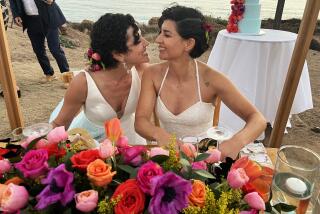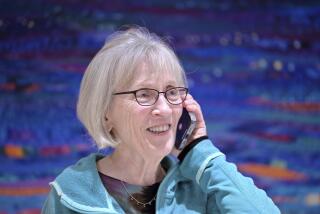Pioneer in Opportunities for Females
- Share via
Beatrice Bain, a California pioneer in the advancement of women in higher education, will be honored at a dinner at UC Berkeley on Wednesday. The event at the Lawrence Hall of Science is a fund-raiser for the Bea Bain Fund. The fund, which has already garnered a $10,000 donation from the Hewlett Foundation, will support the Math/Science Network, an organization Bain helped found to encourage women and girls to achieve their career goals, particularly in non-traditional fields.
Bain was a co-founder and first associate director of the Center for the Study, Education and Advancement of Women (Women’s Center) at Berkeley in 1973, and as an adjunct professor at San Francisco State she taught one of the nation’s first university courses on women. She moved into administration and devoted herself to developing opportunities for women and minorities in higher education. Bain, who is ill with cancer, most recently has served as recruitment and advancement coordinator in the office of the Vice President for Agriculture and Natural Resources for the University of California.
Homemaker for 17 Years
In an interview in the newsletter of American Women in Science, Bain said that her own experiences motivated her work on behalf of women. She received her bachelor’s degree in political science at Berkeley in 1936 and a master’s in history at Radcliffe the following year. She began work on a doctorate but, like many young women of this era, when her husband won his first academic appointment, she went “back home,” as she put it, and didn’t finish her thesis. Except for a brief period teaching at Berkeley during World War II, she was a homemaker for 17 years, rearing a son and a daughter.
Discrimination certainly would have affected her career in her field had she pursued it in the 1940s. During the war, like an academic Rosie the Riveter, she said: “I got a chance because available manpower was scarce. Women at that time ‘couldn’t handle political science’ in the words of the department chair.”
She returned to work in 1957. “I was very concerned both at the waste of educated, talented women and at the insensitivity of the educational institution that wouldn’t allow women with an interrupted education to return to mainstream graduate programs,” she said.
Sponsors of the dinner include the American Assn. for the Advancement of Science, the Women’s Center at Berkeley, the Association for Women in Science and a number of other organizations.
A new free brochure, “Protect Yourself: An Older Women’s Guide to Pension Rights,” has been published by the American Assn. of Retired Persons. Putting one’s faith in pension plans without fully understanding them is “particularly dangerous if you are a woman,” according to the AARP.
The publication provides a list of questions women of all ages should ask themselves about their own and their husbands’ pension plans and explains how the passage of the Retirement Equity Act of 1984 helped to end some, but not all, pension inequities.
According to Social Security figures, in December, 1984, the average woman retiree received a monthly benefit of $396 compared to $518 for retired male workers. Disabled women who had worked received $371, disabled men $519. Elderly women constitute 70% of the elderly poor, with half of elderly single white women and 80% of elderly black single women living at or near the poverty level.
The AARP’s publication is part of its new Women’s Initiative, a program designed to respond to the special concerns and interests of midlife and older women. A free copy of the pension brochure is available by writing AARP Fulfillment, 1909 K St., N.W., Washington, D.C. 20049.
The trend in marriage in America is toward marrying at a later age and staying married a shorter time according to a new analysis of Census data from the Population Council, a nonprofit research organization based in New York.
The average age of a first marriage for women rose from 20.3 to 22.5 between 1962 and 1982; the proportion of never-married women between 25 and 29 rose from one in 10 in 1970 to almost one in four in 1982. Patterns for men were similar.
The average duration of a marriage is 22.5 years for white women, 15 years for black women, although the divorce rate for the two groups is almost the same and has risen at almost the same rate. The council said that since 1940-45 the divorce rate has increased from 14% for white women and 17.6% for black women to 45.2% and 47.1%, respectively. Almost half of all weddings involve at least one partner who has been married previously.
Reasons for Trend
Among the reasons for marriage becoming less central to life are the rise in women’s earnings and a fall in fertility--both of which “reduce the advantage” of marriage to women. Also, the researchers said, the stability of marriage tends to be related to a balanced sex ratio in the population. And since World War II, there has been “a shortage” of men, particularly black men, available as marriage partners.
“Whatever its cause,” wrote Thomas Epenshade, who conducted the research that was reported in the June issue of Population and Development Review, the council’s journal, “the decline in marriage is having substantial repercussions.” Among them are that the rate of illegitimate births quadrupled between 1940 and 1980 (despite the fact, the report also notes, that the rate of illegitimate births to nonwhite people has been dropping since 1960) and the number of children living in single parent households has doubled since 1970.
More to Read
Sign up for Essential California
The most important California stories and recommendations in your inbox every morning.
You may occasionally receive promotional content from the Los Angeles Times.










